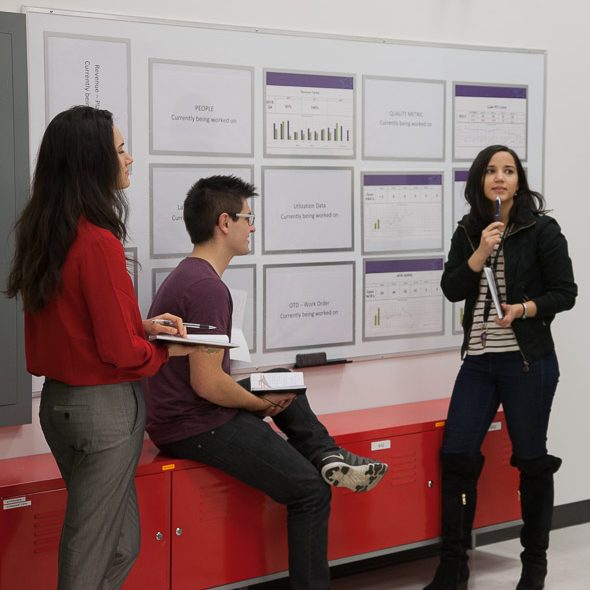
Lean Small Scale Manufacturing
When most people think of Lean Manufacturing, they think of large, gleaming, gazillion square foot manufacturing spaces where every surface is clean, meticulously labelled and taped off. Happy workers reach for their conveniently placed tools on their shadow boards and work on mistake-proof assembly stations. They think of Toyota, or Boeing, or any manner of billion dollar businesses that have invested a lot into leaning out their operations. That can be quite intimidating for small companies on tight budgets with little headroom to get their Lean Small Scale Manufacturing journey started.
The idea of taking someone off of the manufacturing floor to participate in Kaizen events, or putting time into implementing 5S principles may seem disruptive. After all, that’s one less person making products.
However, a culture of continuous improvement has proven time and time again to bring more profits and produce better quality products. Lean for small scale manufacturing reduces costs and increases productivity. You don’t need to set up one piece flow and understand the minutia of takt time for one person working on a single product building 10 of per year. You can go that far, but there are other, less intimidating ways to foster a culture of continuous improvement in Lean Small Scale Manufacturing.
The best part? It doesn’t have to be expensive or onerous to implement. Here are some practical ways we implement basic lean concepts for small volume, complex medical devices.
- Implement Daily Kaizen – If you’re not having a morning huddle with your team to discuss the day’s work, start one. As a part of that, we go through the process of designing and reviewing a Daily Kaizen board, where employees can make improvement suggestions and be able to implement those as a part of their daily activities.
Design the Kaizen around the Plan Do Check Act (PDCA) cycle and review daily until the implementation of the improvement is verified and can be celebrated. To make sure that improvements are not overwhelming, we limit the number of improvements that our team will be working on at a time. Three to five is a good number for a small team to be able handle at once. Ensure that the person undertaking the improvement understands how much time they should be spending daily, and what timeframe is reasonable to Plan and Do the improvement. As a part of the Plan stage, we make sure we are utilizing good data and solving the right problem.
When employees are actively improving their own processes and work areas, they are more engaged with their employer and the success of the business. And when they get to the Check and Act stages, our employees can clearly see how their suggestions have contributed to improving efficiencies, and therefore the bottom line.
- 5S Your Manufacturing Floor – Sort (Seiri), Set in Order (Seiton), Shine (Seiso), Standardize (Seiketsu), Sustain (Shitsuki)
Employees are healthier and up to 5% more productive when their workspaces are clean and organized. They also maintain focus on their tasks for longer when their workspaces shine. 5S principles are easy to follow and employees are more likely to sustain their workspaces when they’ve had a hand in organizing it themselves.
Some floor tape, a photocopier, pegboard and signage are all that’s needed to start on 5S. One workstation at a time, 15 minutes a day, and you will be well on your way to organizing and beautifying your manufacturing space. Get rid of unused items. Designate an area for moving waste off the manufacturing floor. Put up shadow boards on workstations for commonly used tools. Put down floor tape to differentiate areas in manufacturing and clearly show where things belong. Add signage to your workstations so it’s easy for all to see the manufacturing flow. Don’t forget to also 5S office areas.
- Implement Kanbans and Point Of Use materials – Even if the volume doesn’t require millions of dollars of inventory to purchase or manage, small run medical devices can benefit greatly by implementing simple materials replenishment programs and stocking materials at their point of use. Production employees signal purchasing when they need more materials before you run into a shortage situation.
Visual programs like two-bin Kanban systems creates efficiencies in purchasing and ensure that production staff have the materials they need to do their jobs without having to rely on an MRP system to tell them what to buy. While Kanbans and POU materials are not appropriate for all types of parts, utilizing them can free up purchasing staff to focus on more complex and expensive materials procurement.
Simple lean concepts can have a significant impact on efficiencies, health and employee engagement and increase productivity. Going Lean is a journey that doesn’t need large volumes or amounts of time and money to implement. Lean small scale manufacturing is highly effective.
Kathy Young is the StarFish Medical Purchasing Manager. Kathy takes a proactive approach to engaging suppliers with the development team throughout the design process.
Images: StarFish Medical
